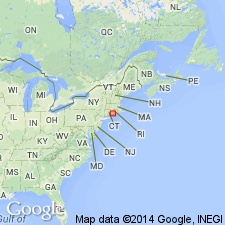
- Usage in publication:
-
- North Plain lithofacies
- Modifications:
-
- First used
- Dominant lithology:
-
- Gneiss
- AAPG geologic province:
-
- New England province
Summary:
Hadlyme Formation of Waterford Complex here defined in the Avalon terrane of eastern CT to include three extrusive volcanic facies: North Plain, Jennings Pond, and Mansfield Hollow lithofacies. Term lithofacies, rather than member, used to convey vertical or chemical continuity, not lateral continuity. North Plain lithofacies (originally Hadlyme belt of Lundgren (1963)) described as a light- to medium-gray weathering plagioclase gneiss that forms most of the footwall of the Honey Hill fault. Contains amphibolite layers 2 to 100 cm thick. Displays strong gneissosity due to preferred orientation of hornblende and biotite. North Plain is at least 25 km long. May be as much as 45 km long. Thickness varies from 0 to 2,000 m thick. 600 m thick in the representative section at Brush Hill-Mitchell Road, Deep River quad.
Source: GNU records (USGS DDS-6; Reston GNULEX).
For more information, please contact Nancy Stamm, Geologic Names Committee Secretary.
Asterisk (*) indicates published by U.S. Geological Survey authors.
"No current usage" (†) implies that a name has been abandoned or has fallen into disuse. Former usage and, if known, replacement name given in parentheses ( ).
Slash (/) indicates name conflicts with nomenclatural guidelines (CSN, 1933; ACSN, 1961, 1970; NACSN, 1983, 2005, 2021). May be explained within brackets ([ ]).

